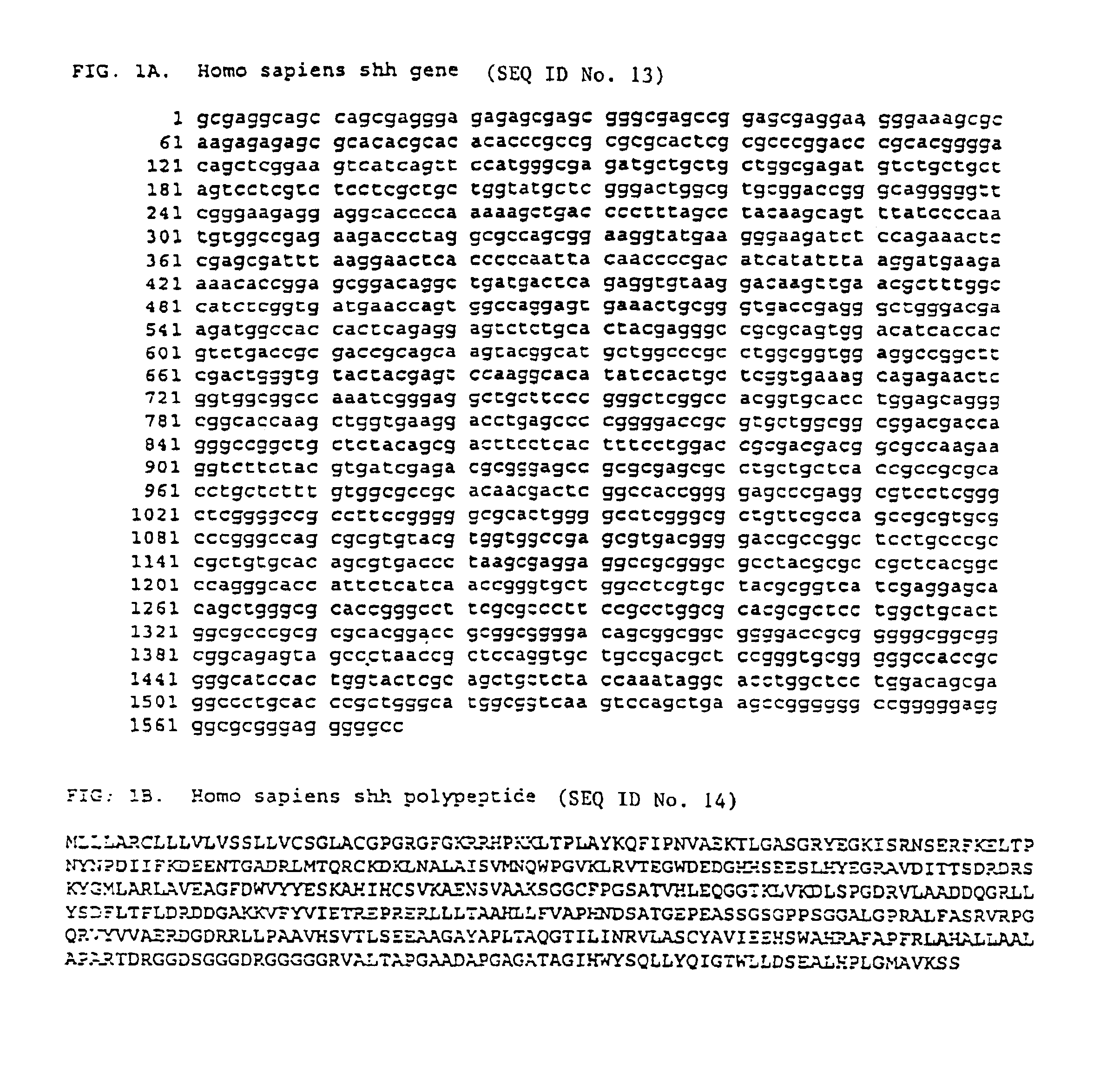Methods to stimulate insulin production by pancreatic beta-cells
a technology of pancreatic beta cells and insulin, which is applied in the field of protein useful for the treatment of diabetes mellitus, can solve the problems of diabetes in patients, and achieve the effect of raising the insulin level in patients
- Summary
- Abstract
- Description
- Claims
- Application Information
AI Technical Summary
Benefits of technology
Problems solved by technology
Method used
Image
Examples
example i
[0135]Components of Hedgehog Signaling are Expressed in Mature Mouse Pancreatic β-Cells, Rat Islet Cells, and Rat INS-1 Cells
[0136]Adult mouse pancreas was examined for the expression of the hedgehog receptor proteins patched and smoothened by immunohistochemistry. As shown in FIG. 10, the hedgehog receptor proteins patched (GenBank Accession No. U46155) (FIG. 10A) and smoothened (FIG. 10C) are expressed in the mouse pancreas islet. Patched and smoothened proteins are expressed in mouse pancreatic β-cells, located within the core of the islet, as demonstrated by their coexpression with insulin (FIGS. 10B, D). For immunohistochemistry, mouse pancreas was embedded in Tissue-Tek O.C.T. compound (Sakura Finetek, U.S.A., Inc., Torrance, Calif.) and frozen on dry ice. Tissue was sectioned at 7 micron increments and fixed for 5 minutes at room temperature in 4% paraformaldehyde in phosphate buffered saline. After multiple washes with phosphate buffered saline, tissue sections were blocked ...
example ii
Hedgehog Regulates Insulin Production
[0143]The results described in Example I demonstrating that hedgehog proteins are expressed in the rat INS-1 cell line and rat islet cells, in conjunction with the demonstration that the hedgehog receptors patched and smoothened are expressed in rat INS-1 cells, rat islet cells, and mouse islet cells, suggest that hedgehog could play a role in the production of insulin by pancreatic β-cells. This potential role was examined with the rat INS-1 cell line, which intrinsically expresses Ihh and Dhh proteins (FIGS. 13 and 14). The cells were treated with the small molecule cyclopamine, a cholesterol derivative that has been shown to inhibit the attachment of the appropriate cholesterol to Shh, thus rendering Shh deficient for signaling (Kim and Melton, 1998, PNAS 95:13036). Cyclopamine was administered to INS-1 cells that were transiently transfected, according to standard means, with an empty vector pEV control and an insulin promoter-reporter constr...
example iii
Hedgehog Regulates the Expression of IDX-1 in Differentiated β-cells
[0146]In addition to regulating the expression of the insulin gene, Shh was found to regulate the expression of the IDX-1 gene (GenBank Accession No. U04833), which in turn could be responsible, at least in part, for the stimulation of the insulin gene in pancreatic β-cells by Shh. The IDX-1 protein is a transcription factor that is also useful for treating diabetes (Habener et al., U.S. Ser. No. 5,858,973). The IDX-1 (also referred to as PDX-1 / IPF-1 / STF-1) protein activates the transcription of the insulin gene of the insulin gene by interacting on a DNA-control sequence known as Far-Flat, which is located in the promoter region of the insulin gene. IDX-1 is essentially required for pancreas development, as the targeted disruption of the PDX-1 gene in mice (IDX-1 in rat nomenclature) results in failure of the pancreas to develop. The corresponding disruption of the expression of the human IPF-1 gene (IDX-1 in rat n...
PUM
| Property | Measurement | Unit |
|---|---|---|
| pH | aaaaa | aaaaa |
| pH | aaaaa | aaaaa |
| body weight | aaaaa | aaaaa |
Abstract
Description
Claims
Application Information
 Login to View More
Login to View More - R&D
- Intellectual Property
- Life Sciences
- Materials
- Tech Scout
- Unparalleled Data Quality
- Higher Quality Content
- 60% Fewer Hallucinations
Browse by: Latest US Patents, China's latest patents, Technical Efficacy Thesaurus, Application Domain, Technology Topic, Popular Technical Reports.
© 2025 PatSnap. All rights reserved.Legal|Privacy policy|Modern Slavery Act Transparency Statement|Sitemap|About US| Contact US: help@patsnap.com



